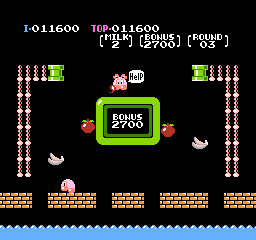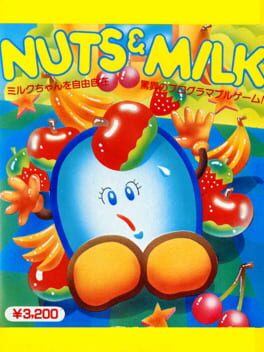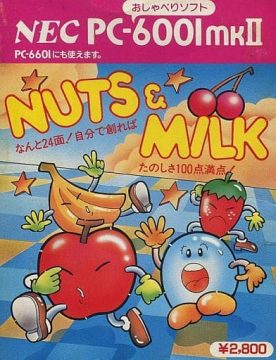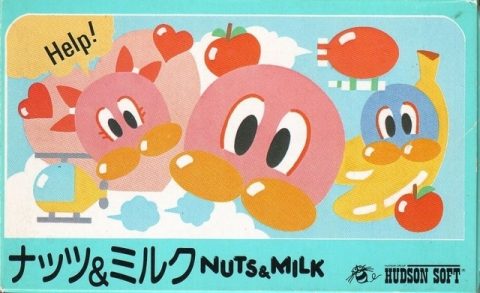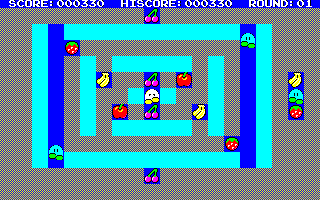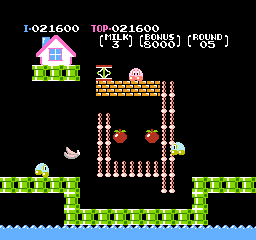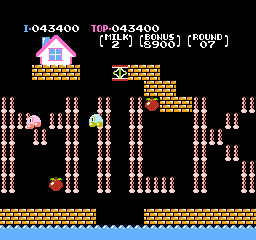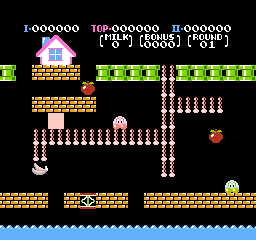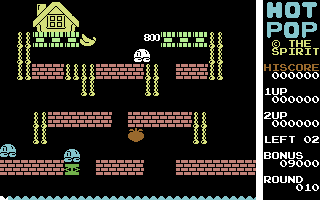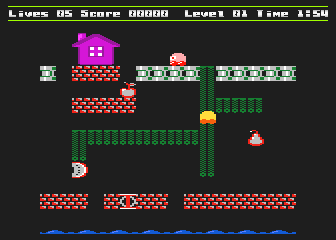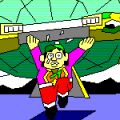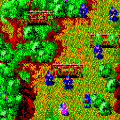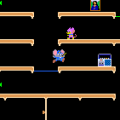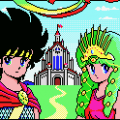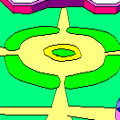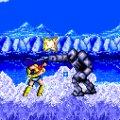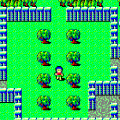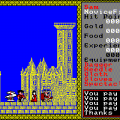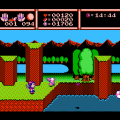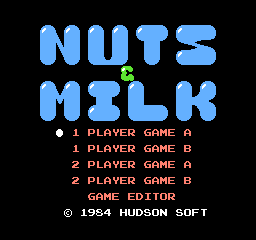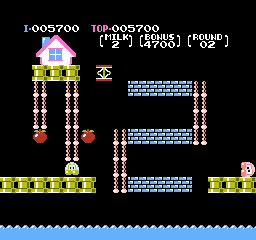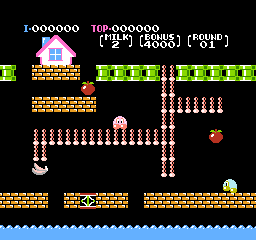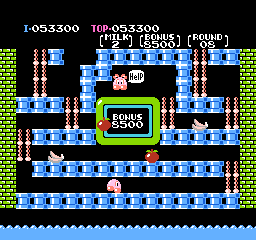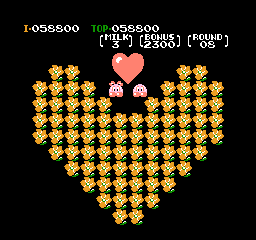Nintendo’s Family Computer had a pretty good start with its initial line-up of quite accurate conversions of their own arcade titles like Donkey Kong, Popeye and Donkey Kong Jr. With time, the offering was expanded by even more ports and original games made specifically for the system. However, the company’s higher-ups knew that their R&D divisions could not keep up with churning out new releases of their own – a cooperation with third-party developers was urgently needed. In the process, Nintendo introduced strict licensing rules so they can filter out shovelware or inappropriate content, while racking up plenty of money in licensing fees. Just one year after Famicom’s launch Hudson Soft, a known name in Japanese home computer software, would offer Nuts & Milk, which solidified them as the first third-party Famicom game developer and a major partner of Nintendo for years to come.
Before its appearance on the red-and-white console, the game was released on various 8-bit computer systems popular in Japan. Not only that, but it’s also a completely different release from what players would see on the Famicom. The computer version of Nuts & Milk is a top-down maze game with a premise similar to that of Pac-Man. You play as Milk – a white-colored blob and your job is to simply collect all the fruit in the stage before reaching a heart symbol, which completes the level. The blue-colored Nuts stand in your way. The difference is in the gray blocks, through which Milk has to dig. Those blocks regenerate after a while, much like ground in Lode Runner, burying either the player or enemies alive – without the score bonus for the latter. Due to running on said 8-bit machines, the presentation isn’t particularly great – blocky text, bright shades of blue and gray filling the screen and movement of the characters is choppy. The MSX version at least includes some simple in-game music, while NEC PC versions just have clicking sounds for the audio. Players can also create their own levels by pressing the Return button at the title screen. The other computer versions don’t differ very much from the PC-88 one.
The Famicom version is vastly different, although some elements from the 8-bit computer original are still there. This time around, the game is a single-screen platformer and the characters are colored differently. Once again, Milk’s task is to collect all the fruit in the stage, while avoiding Nuts at the same time. Then the player has to reach the house in the upper left corner, where Milk’s fiancée, Yoghurt, is waiting. This makes the game even more similar to Lode Runner, ported to Famicom by Hudson themselves just a few days later. It also ditches the computer version’s blue and grey color scheme for a black one, similar to other Famicom games.
Unlike the Runner, Milk can jump, and he often has to, either to overcome gaps and obstacles or evade the malicious Nuts. The jumping is similar to that in Donkey Kong – once a jump button is pressed, the character’s trajectory can’t be altered. Falling from greater heights would certainly hurt Jumpman, but Milk can shrug it off. Not without problems though, as spending too much time in the air causes our protagonist to roll over and fall on his side, paralyzing him for a while before he can get up. And that often is a sure way to lose a life at the hands of Nuts. Jumping over one tile-wide gaps isn’t much of a fuss, but wider ones require nearly pixel-perfect precision. There are also numerous springs that can launch Milk very high when the player presses the jump button shortly before landing on one of these.
The game comprises a whopping fifty unique stages as opposed to titles from Nintendo’s own line-up of arcade ports, which feature just from three to four levels per loop – really impressive for a game stored on an NROM cartridge. Stages 3 and 8, then 13 and 18, etc. are bonus rounds where the player is able to score some more points by collecting fruit, but more importantly, obtain an extra life by reaching Yoghurt within a very strict time limit – all while being harassed by familiar looking fireballs. The quicker you get to the end of each level, the more bonus score you earn at the end of each round. Traditionally, the game loops back to the first stage upon beating all the levels. The second loop introduces two flying things – when Milk faces the right side of the screen, a yellow helicopter that can be collected for points appears, but when he faces the left side, a red blimp shows up, and you’d better not touch it! As per Nintendo’s standards at the time, the player can choose to start the game on the higher difficulty right away.
Much like the home computer counterparts, the Famicom version of Nuts & Milk also features an edit mode. After a successful editing, user-made round replaces the very first stage, with the rest of the game left untouched. The ability to save the custom level onto a cassette tape via Data Recorder, as seen in later games such as Lode Runner or Excite Bike is not included here. Fortunately, there’s an unofficial tool for Windows PCs at Romhacking.net, which allows you to alter any of the 50 stages and save them within a modified ROM of the game, which later can be launched via an emulator or a flashcart.
When looking at the game for the first time, one might think this game belongs to Nintendo’s own early line-up of arcade-derived titles. From the title screen layout and options, fireballs straight from Mario Bros., to score and life display in the game itself, Nuts & Milk indeed looks like a first-party release. Similarities don’t end on visuals – the gameplay itself is pretty much Donkey Kong sans falling damage, the water hazard at the bottom and the ability to go around screen borders are inspired by Popeye. Some might call it a shameless rip-off, but Hudson clearly wanted the game to look and feel familiar to players already accustomed to Nintendo’s own works.
The Famicom version of the game was ported to the Commodore 64 home computer as Hot Pop. It plays more or less the same, with some minor differences, such as fruits not moving during bonus stages. Nuts & Milk, among other early Hudson titles, was featured on Hudson Best Collection Vol. 4 for Game Boy Advance in Japan only, which plays and looks almost identical to the home console version, albeit running in a slightly downscaled resolution and without the 2-player and level editor options at the title menu. There’s also a fan-made port for the Atari 8-bit computers called Nuts Milk with decent graphics, complete lack of sound effects and way choppier jumping mechanics. The goal of bonus stages in this one is not rescuing Yoghurt as quickly as possible, but to gobble up as many fruit as you can within the fairly large time limit.
